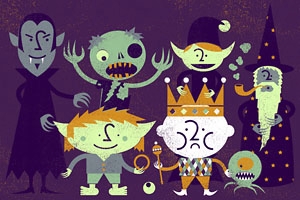Literature
Wild about Harry and Hobbits: Behind Fantasy's Appeal

The Hobbit: An Unexpected Journey, Peter Jackson’s film adaptation of J.R.R. Tolkien’s original tale, broke the December box office record for biggest opening weekend.
Following in the footsteps of Jackson’s Lord of the Rings trilogy, the Harry Potter films, the Chronicles of Narnia films, and the Twilight films, it is the latest in a more than decade-long series of Hollywood blockbusters based on popular fantasy literature.
But fantasy is hardly a new genre. Tolkien’s The Hobbit, credited with helping to “mainstream” fantasy in the twentieth century, recently celebrated its 75th anniversary. Before it, numerous precursors date far back beyond fairy tales and Arthurian literature to ancient works such as Homer’s The Iliad and The Odyssey. So why is fantasy experiencing a renaissance of sorts now?
Charles Cox, senior professorial lecturer in the Department of Literature at AU, says the answer is more complex than simply “escapism” as all entertainment provides a way to escape our day-to-day lives.
“For many viewers, I think it’s the perceived simplicity of traditional fantasy—the sorts of fantasy we’re seeing the most of in Hollywood usually make the line between good and evil very clear and stark,” said Cox, whose academic interests include the cultural role of the popular genres fantasy and science fiction.
“For some people, that sort of thinking can be very appealing in politically-charged and economically precarious times, Cox said. "The real world is morally murky and troublingly complex, so the black-and-white worlds of traditional fantasy can be a calming antidote to that.”
Beyond Good v. Evil
But according to Cox, if we look beyond the simple appeal of good v. evil and the special effects that can make fantasy fantastic on the silver screen, we will discover that fantasy actually can help us better understand and deal with the complexities and challenges of reality.
“Fantasy, and related genres like science fiction, are often metaphorical,” Cox said. “The worlds of fantasy mirror our own, but in distorted ways—ways that exaggerate and estrange, making us see ourselves in a new light.”
For example, Cox explains, in The Lord of the Rings, Tolkien connects the good characters and races closely to nature, while the forces of evil are heedless of nature and often use technology to nature’s detriment.
“For Tolkien, this was a way of capturing what he saw as a dying English way of life in the first half of the twentieth century,” Cox said. “Modern viewers, whether they recognize it or not, may feel echoes of current worries over environmental devastation and the dangers of unchecked industry.”
But, Cox contends, the key is that the message is communicated indirectly, so it doesn’t come across as “preachy” like it would in a realistic, contemporary story.
Balancing the Familiar and the Strange
For most, the word “fantasy” conjures up images of magic, strange, far-away lands, and mythical creatures. But Cox says there is a lot more to the fantasy genre than wizards, kings, queens, dragons, and unicorns.
“Most people are familiar with what we call ‘high’ or ‘epic’ fantasy—such as the works of Tolkien and C.S. Lewis,” Cox said. “But it’s actually a much more diverse genre than people realize, especially in print literature, where you can find dark fantasy, comic fantasy, urban fantasy, steampunk, sword-and-sorcery—just to name some of the most common forms.”
One of the hallmarks of high/epic fantasy is the stark good v. evil story line. While this is not a hallmark of all fantasy sub-genres, Cox says all commercially successful fantasy works do share one quality: balancing the familiar and the strange.
“Readers and viewers want something that gives us a sense of wonder, a glimpse at the impossible made real, sights we’d never otherwise see,” Cox said. “But we don’t want something so utterly fantastical and unfamiliar that we can’t see ourselves reflected in it."
Something for Everyone
Fantasy appeals to multiple generations. Parents are often as eager as their children to read the latest book or see the new movie adaptation of a popular fantasy series. Classics, such as The Hobbit, The Chronicles of Narnia, and The Wizard of Oz, are “rediscovered” when parents share them with their children. Longevity, it seems, is built-in.
“Everyone, regardless of age, confronts challenges and feels thwarted by ‘evil,’ whether it’s the bully on the playground, the tyrannical boss or teacher, or that pile of unpaid bills,” Cox said. “High fantasy stories, with the underdog hero overcoming the evil, reassure us that someday, some way, we will triumph. And, despite many adults’ denials, this need never goes away.”
But Cox says the longevity of the fantasy renaissance we are experiencing now is more likely made possible by the genre’s diversity.
“There are so many different popular fantastical shows, films, and novels that you can find your own niche,” Cox said. “If you don’t like hobbits and elves, there are zombies and vampires. If you’re not into superheroes, there are fairy tales. This openness to various types of stories may keep the trend from burning out as quickly as other trends do.”
